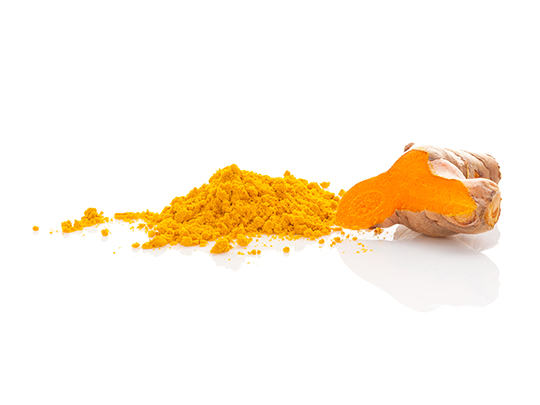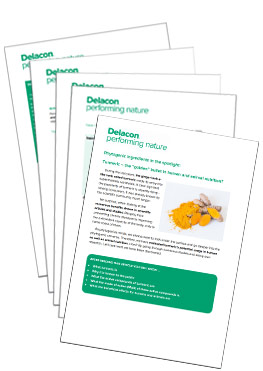Turmeric – the “golden” bullet in human and animal nutrition? (part 3)
Does turmeric influence the performance of livestock animals? Find it out and explore various scientific approaches and effects between in vivo and in vitro research.
We already put our golden spotlight on the orgin and active ingredients (part 1) as well as the influence on the physiology (part 2) in our previous turmeric articles.
Are you already thinking about integrating tumeric in your feeding program? We are sure that you need more infomation about other parameters, before you can answer this question positively. Perfect timing to look at turmeric’s influence on animals’ performance – in vitro as well as in vivo.
After reading this article you will know
- how turmeric actively influences the physiology
- what the key factor NF-κB is
- more about the situation of turmerics’ effects regarding health in vivo
- more about the antidiabetic efficacy of curcumin
What about the performance of turmeric regarding livestock animals?
In contrast to the detailed effects on inflammatory and oxidative processes observed in vitro with pure curcumin, in vivo studies using turmeric rhizomes and its preparations show inconsistent results on health-related parameters. Therefore, it is important to carefully review studies in livestock animals to evaluate potential growth performance enhancing effects. Studies cited in Table 1 show effects of dietary supplementation with turmeric rhizome powder on growth performance in broiler chickens. The results reveal inconsistent effects on growth performance, although similar concentrations have been used in these studies. However, there seems to be at least some consistency in improving feed efficiency in poultry. In post-weaning piglets, two studies with dietary inclusion of turmeric rhizome powder or curcumin showed no effects on growth performance. Based on the small sample size of these studies, it can be concluded that in vivo effects on growth performance in poultry and pigs are not consistent.
| Trial setup | Trial duration [days] | Dusage in feed [g/kg] | Results | Reference |
|---|---|---|---|---|
| 60-day old Coob broiler; 10 birds/pen; 3 pens/treatment | 35 | 0; 5 | After 35 days no effects on BW gain or feed intake, FCR improved with turmeric supplementation | Abou-Elkhair et al., 2014 |
| 112-day old Ross 308 broiler; 14 birds/pen; 2 pens/treatment | 42 | 0; 2; 4; 6 | After 42 days BW and BW gain (day 42) were higher for 2 g/kg and 4 g/kg turmeric powder compared to the control. Feed conversion ratio was improved with 4 g/kg compared to the control. | Al-Mashhadani, 2015 |
| 120 day old Vencobb broiler; 10 birds/pen; 3 pens/treatment | 42 | 0; 1; 2 | After 42 days no effects on BW | Mehala and Moorthy, 2008 |
| 120 day old Hubbard broiler; 10 birds/pen; 4 pens/treatment | 35 | 0; 5; 10; 15 | 10 g/kg and 15 g/kg increased BW gain and improved FCR compared to control and 5 g/kg. In additin, 5 g/kg improved FCR compard to the control | Arslan et al., 2017 |
| 120 day old Ross 308 broiler; 10 birds/pen; 4 pens/treatment | 42 | 0; 2.5; 7.5 | After 42 days no effects on weight gain and but improved FCR at 2.5 g/kg turmeric powder | Naderi et al., 2014 |
In vivo vs. in vitro: What makes the difference?

In vivo
In vivo, mostly ground rhizomes of turmeric are used as food or feed supplement, were active substances need to make the passage through the intestinal tract. From there, they need to be absorbed into the bloodstream and transported through the body for systematic effects. However, the bioavailability of curcumin is poor and the low uptake through the intestinal tract may be one of the main issues, why inconsistent effects are observed in animals and humans. In addition, ground rhizomes as natural product vary in their composition depending for example on harvest time, environmental conditions and variety. Similar quantities of turmeric powder might therefore differ significantly in their content of active substances.

In vitro
In contrast, most in vitro experiments use cell cultures and the pure active compounds, especially curcumin, will be applied
directly on these. Therefore, the issues of varying concentrations of actives and transportation to the site of interest are no issue in vitro. These circumstances may be an explanation for the difference between in vivo and in vitro observation.
Do you want the entire article as PDF including all references?

You are only one click away.

Tobias Aumiller
Scientific Lead and deputy Head of R&D at Delacon. In 2015, Tobias Aumiller joined the Delacon family as Research and Development Manager for Swine and Microbiology. He received his diploma in Technical Biology and completed his Ph.D. in animal nutrition at the University Hohenheim in 2015, focusing on feed-gut-microbiota interaction. In his leisure time Tobias loves playing table tennis and also participates in championships.










